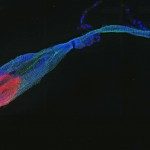Lien vers Pubmed [PMID] – 23764031
Malar. J. 2013 Jun;12:204
BACKGROUND: The Anopheles gambiae sensu lato (s.l.) species complex in Burkina Faso consists of Anopheles arabiensis, and molecular forms M and S of Anopheles gambiae sensu stricto (s.s.). Previous studies comparing the M and S forms for level of infection with Plasmodium falciparum have yielded conflicting results.
METHODS: Mosquito larvae were sampled from natural pools, reared to adulthood under controlled conditions, and challenged with natural P. falciparum by experimental feeding with blood from gametocyte carriers. Oocyst infection prevalence and intensity was determined one week after infection. DNA from carcasses was genotyped to identify species and molecular form.
RESULTS: In total, 7,400 adult mosquitoes grown from wild-caught larvae were challenged with gametocytes in 29 experimental infections spanning four transmission seasons. The overall infection prevalence averaged 40.7% for A. gambiae M form, 41.4% for A. gambiae S form, and 40.1% for A. arabiensis. There was no significant difference in infection prevalence or intensity between the three population groups. Notably, infection experiments in which the population groups were challenged in parallel on the same infective blood displayed less infection difference between population groups, while infections with less balanced composition of population groups had lower statistical power and displayed apparent differences that fluctuated more often from the null average.
CONCLUSION: The study clearly establishes that, at the study site in Burkina Faso, there is no difference in genetic susceptibility to P. falciparum infection between three sympatric population groups of the A. gambiae s.l. complex. Feeding the mosquito groups on the same infective blood meal greatly increases statistical power. Conversely, comparison of the different mosquito groups between, rather than within, infections yields larger apparent difference between mosquito groups, resulting from lower statistical power and greater noise, and could lead to false-positive results. In making infection comparisons between population groups, it is more accurate to compare the different groups after feeding simultaneously upon the same infective blood.

